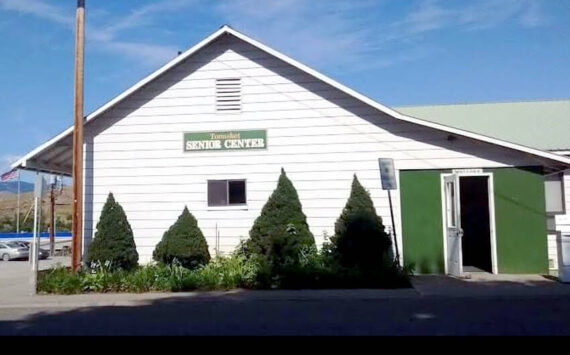Zwicker takes it as vote of confidence
NORTH COUNTY – North Valley Hospital held two community forums in Oroville and two in Tonasket last week to answer any questions the public might have about the geo-thermal project the hospital district is in the process of implementing for their heating and cooling needs. Three of the forums had zero attendance and two people attended the fourth one, held Wednesday, June 8 at the Tonasket Senior Center.
“The reason for the forums was due to some concerns I heard from the communities in Oroville and Tonasket,” said NVH CEO Mike Zwicker. “The comments were not negative, but concerned citizens making sure NVH performed their due diligence on this project. The public in both communities spoke out and NVH is listening to their concerns; therefore, NVH provided the opportunities for the public to ask their questions and voice any concerns.”
Zwicker said he took the lack of public participation at the forums as “a good sign the community is building trust” in the decision-making of the hospital board.
“If the community has any more questions, they are welcome to bring them to my attention,” said Zwicker.
Traveling to Oroville and Tonasket to answer questions and provide information on how the geo-thermal system will work were David Franklund of KDF Architecture and Kirsten Wilson, Energy Systems Engineer with the Washington State Department of Enterprise Services Energy Program (DES Energy Program).
McKinstry is the company designing, developing and constructing the project, and KDF was hired by the hospital directly to look at what had been proposed and develop the information presented at the forums.
NVH began looking into improvements to the existing hospital in 2007, wanting to explore energy efficiency before the new addition to the hospital was built. “At the time no projects were identified after the hospital passed a bond building the new addition as it took all their resources, so the project was shelved,” said Wilson, adding the conversation was re-engaged in 2013 because of issues with the central boiler plant.
A propane option was rejected because there was nowhere to install a propane tank large enough to accommodate the needs of the hospital district. An electrical system could have been put in, but not without a lot of infrastructure improvement being done to the hospital to accommodate the load; which would have been 50 percent more expensive than the geo-thermal.
“We determined the geo-thermal system was the best, as it addressed both heating and cooling needs at NVH and was the most cost-effective,” said Wilson.
Franklund said in comparing mechanical system replacements, cost comparisons were looked at as well as the ability to get grants; in choosing geo-thermal NVH was eligible for a $500,000 grant, which they have received but not yet spent. According to cost figures worked out in 2013, the annual utility savings of ground source heat (geo-thermal) is $75,754, “so the simple payback in years would be about 21, counting what has already been done and the grant,” said Franklund.
The cost of the geo-thermal system is approximately $2.8 million overall, of which the hospital has expended a little over $700,000 to date.
Wilson said as a project team, they decided to implement the project in stages, with one stage being completed with the replacement of an existing steam boiler with a high efficiency hot water boiler.
“We started with the boiler because the existing boiler was failing and needed to be replaced. We had about an eight-week window to come up with something that would work, and you can’t develop a geo-thermal system in an eight week time frame,” said Wilson.
The hot water boiler will eventually be part of the geo-thermal system. Wilson explained the geo-thermal system will be able to meet the needs for cooling and heating water to a certain temperature, but beyond that temperature the hot water boiler would be used to supplement the system.
Wilson said the next step will be to drill a test well and then drill and develop four wells on NVH property; two up by the Family Health Center which would take water out of the ground and two more between NVH and the Eagles Hall which would put the water back into the ground.
“In the summer you take the heat out of the building and dump it in the water, and in the winter you take the heat out of the water and dump it in the building,” said Wilson, adding that water is a substance from which heat can easily be transferred. “The idea of moving heat from one place to another makes this concept more efficient, as it takes less energy to move heat than to create heat.”
“It’s a very efficient system to use in hospitals, and it creates a more comfortable environment than just using air,” said Franklund.
According to Franklund, the geo-thermal system would have “very little effect on the aquifer, as the heat going into the ground would only be about 66 degrees.” The aquifer maintains a year-round temperature of 55 degrees.
Franklund also said the wells would all be far enough away from any other wells so as not to heat them.
“In the summer the system is reversed. We take heat out of the water, and we’re re-injecting colder water back into the aquifer. It’s 55 degrees coming out, and put back in at about 47 degrees,” said Franklund, “so the only fluctuation in the aquifer is seasonal, dependent on the river flow, not temperature changes.”
Called an open loop geo system, the aquifer is part of the loop. Franklund said a lot of closed loop systems are done on the West Side, but are a lot more expensive.
The four heat recovery chillers to be installed are capable of both heating and cooling at the same time, called simultaneous load serving.
“If they are doing a surgery and need cold air, but the rest of the hospital needs heat, these kinds of systems are efficient and comfortable,” said Franklund.
Regarding concerns about the possibility of contaminating the atmosphere, Franklund said “the system would be putting back in the same amount of water it was taking out, and it is taken out through a heat exchanger. So we’re not pumping water into the hospital; it is cycled through without the two touching each other.”
The ground water is separated by a cleanable, replaceable plate exchanger.
Franklund said the key issues remaining were to first drill test wells and then the wells.
“The risk is if you don’t get the amount of water you planned on, in which case our fall back plan is diesel boilers,” said Franklund.
A feasibility assessment has already been performed by Linton Wildrick, Hydrogeologist with Pacific Groundwater Group.
“We have to have test wells done first to confirm a good viable water source, but most of us are confident it is there,” said Wilson, adding that when she recommended to McKinstry that they witch it, she was told no at that time. Wilson said the test wells would be drilled this summer.
Franklund said the other concern was water quality, but the ground water is separated by the heat exchanger, which is cleanable and replaceable and the internal looped system is closed, and able to treat the water.
“Any system that uses boilers treats the water,” Franklund added.
The other concern addressed was payback, with Franklund pointing out that other systems had much longer paybacks.
Franklund said photovoltaics would not be feasible for a facility as large as the hospital district, but the system could be supplemented with photovoltaics in the future.
“This system is already installed in the Oroville School District, and it has been more efficient than we originally expected,” said Wilson, adding that it was installed in the elementary school around ten years ago and into the high school about two years ago.
Franklund said a geo-thermal system was installed in the Brewster School District about 30 years ago, and geo-thermal system is currently under construction for the Okanogan County Courthouse.
“Our conclusion is the hospital board feels they have found a fiscally responsible solution,” said Franklund.
Also in attendance at the forums with Zwicker were Maintenance Supervisor John Sanchez and Administrative Secretary Brenda Turner.




